
Alexander Jackson Davis, or A. J. Davis, was an American architect, known particularly for his association with the Gothic Revival style.

The Pellissier Building and adjoining Wiltern Theatre is a 12-story, 155-foot (47 m) Art Deco landmark at the corner of Wilshire Boulevard and Western Avenue in Los Angeles, California. The entire complex is commonly referred to as the Wiltern Center. Clad in a blue-green glazed architectural terra-cotta tile and situated diagonal to the street corner, the complex is considered one of the finest examples of Art Deco architecture in the United States. The Wiltern building is owned privately, and the Wiltern Theatre is operated by Live Nation's Los Angeles division.

Buffalo City Hall is the seat for municipal government in the City of Buffalo, New York. Located at 65 Niagara Square, the 32-story Art Deco building was completed in 1931 by Dietel, Wade & Jones.

Ogden High School is an Art Deco secondary school located in Ogden, Utah, educating students in grades 10–12. Operated by the Ogden City School District, Ogden High enrolls approximately 1,250 students each year. The graduation rate has increased dramatically over the past three years. The school houses an International Baccalaureate Programme, a Project Lead the Way program and a thriving Life Sciences/Pre-Med program. OHS also offers a dozen AP classes and the AVID program. The most recent state championship is for girls soccer 2019. The Ogden High mascot is the Tiger. In 2012, Ogden High School began offering International Baccalaureate courses and in 2014 graduated the first IB Diploma Programme class.

The Haish Memorial Library was designed by Chicago architects White and Weber and built in the art deco style of the 1930s with funds left to the library by Jacob Haish in his 1928 will. The building was added to the National Register of Historic Places in 1980.

The Oregon Commercial Historic District is a historic district in Oregon, Illinois, that has been listed on the National Register of Historic Places since 2006. The district is roughly bordered by Jefferson, Franklin, 5th and 3rd Streets in Oregon. It is one of six Oregon sites listed on the National Register and one of three to be so listed since the turn of the 21st century. The other two are the Oregon Public Library, listed in 2003, and the Chana School, listed in 2005.
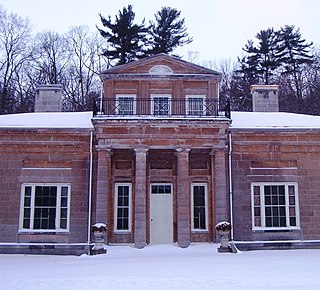
Hyde Hall is a neoclassical country mansion designed by architect Philip Hooker for George Clarke (1768–1835), a wealthy landowner. The house was constructed between 1817 and 1834, and designed with English and American architectural features. It was designated a National Historic Landmark in 1986 for its architecture, and the completeness of its architectural documentary record. It is one of the few surviving works of Philip Hooker, a leading 19th-century American architect.

The Las Vegas High School Historic District in Las Vegas, Nevada is a historic district which includes 11 buildings on the 15 acres (6.1 ha) campus of the school district. It was listed on the National Register of Historic Places in 2022.

The U.S. Post Office in Middleport, New York, is located at Main and Church streets. It is a brick building erected in 1940, serving the 14105 ZIP Code, which covers the village of Middleport and surrounding areas of the towns of Hartland and Royalton.

The United States Courthouse, also known as the Federal Building, is a historic building located in Davenport, Iowa, United States. It has historically housed a post office, courthouse, and other offices of the United States government. The building now serves only as a federal courthouse, housing operations of the eastern division of the United States District Court for the Southern District of Iowa. In 2018, the operations of the Rock Island division of the United States District Court for the Central District of Illinois were also moved there.

The Ridgeland–Oak Park Historic District is a historic district in Oak Park, Illinois that was listed on the National Register of Historic Places in 1983. It includes 1558 contributing buildings over 539 acres (218 ha).

Tindley Temple United Methodist Church, also known as Tindley Temple Methodist Episcopal Church and Calvary United Methodist Church, is a historic Methodist Episcopal church located in the Southwest Center City neighborhood of Philadelphia, Pennsylvania. It was built between 1923 and 1928, and is a large masonry building influenced by the Beaux-Arts Romanesque and Art Deco styles.

The Buckingham Building is a 27-story skyscraper located at 59-67 E. Van Buren St. in the Loop neighborhood of Chicago, Illinois. The building, which opened in 1930, has historically served as a mixed-use retail and office building. Chicago architects Holabird and Root designed the building in the Art Deco style. It was added to the National Register of Historic Places on August 10, 2000.
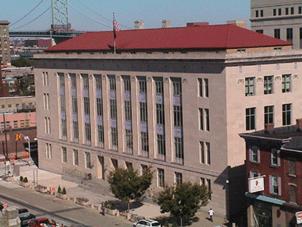
The United States Post Office and Courthouse (1932) and the Mitchell H. Cohen United States Courthouse (1994) house the United States District Court for the District of New Jersey in Camden, New Jersey. The back-to-back buildings are joined by a second story enclosed skyway.

The Main Library is a historic library on the campus of the University of Illinois Urbana-Champaign in Urbana, Illinois. Built in 1924, the library was the third built for the school; it replaced Altgeld Hall, which had become too small for the university's collections. Architect Charles A. Platt designed the Georgian Revival building, one of several on the campus which he designed in the style. The building houses several area libraries, as well as the University Archives and the Rare Book & Manuscript Library. The Main Library is the symbolic face of the University Library, which has the second largest university library collection in the United States.
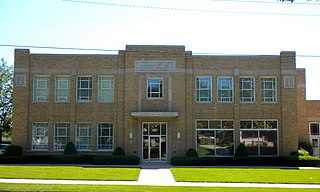
The Coca-Cola Bottling Company Building is a historic Coca-Cola bottling plant located at 616 North 24th Street in Quincy, Illinois. The building was constructed in 1940 for the J. J. Flynn Co., Coca-Cola's regional bottling company in Quincy and one of six Coca-Cola bottlers in Illinois. Local architect Martin J. Geise designed the Art Deco building, one of the few examples of Art Deco in an industrial building in Quincy. The building's design features a projecting central entrance with a high roof line, pilasters with terra cotta decorations at the front corners, and brick columns dividing the front windows; the features combine to give the building a strong vertical emphasis, an important Art Deco aesthetic. Some features of the emerging Art Moderne style are present in the building, including a stone string course, a flat overhang covering the entrance, and a flat roof.
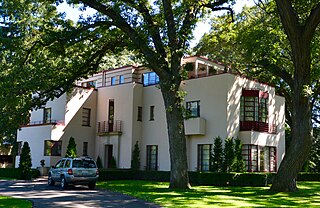
The Robert Hosmer Morse House is a historic house at 1301 Knollwood Circle in Lake Forest, Illinois. Built in 1932, the house served as a summer home for businessman Robert Hosmer Morse and his family. The architectural firm of Zimmerman, Saxe & Zimmerman designed the house, which combined elements of the Moderne and Art Deco styles. As the wealthy residents of Lake Forest typically used traditional designs for their homes, the modern architectural styles were an unusual choice. The house's design features a stucco exterior, a horizontal emphasis throughout, casement windows, decorative limestone around the front entrance, and a recessed third floor.
The Louis Fredrick House is a house designed by Frank Lloyd Wright at 19 W. County Line Road in Barrington, Illinois. The house was built in 1957 for Louis Fredrick, an affluent interior designer. The house's design is typical of Wright's later work, in which he adapted his Usonian design principles to larger homes for wealthier clients. Fredrick played a role in the design process as well, rejecting Wright's original plan on account of its concrete block walls and providing input on decisions such as coloring. The house's design includes a brick exterior, long horizontal window bands, a low roof covered with cedar shakes, and a large chimney.
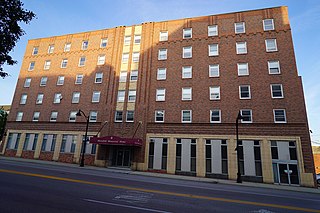
Hotel Belleville is a historic hotel building at 16 S. Illinois Street in Belleville, Illinois. The hotel was built in 1930–31 to replace the city's previous hotel, the Belleville House; like its predecessor, the hotel marketed itself as the most luxurious and modern hotel in Belleville. Architects Manske & Bartling designed the building in the Art Deco style; their design included first-floor window bays with terra cotta blocks, brick pilasters above the entrance, ornamental brickwork on the upper floors, and a parapet. The hotel's amenities included a restaurant and cocktail lounge, banquet and event space, office space for community organizations, and storefronts for local businesses. In the decades after it opened, the building served both as a center of Belleville's social life and a home for regional conventions. The hotel operated until 1961, when it was converted to an assisted living facility for the elderly.

Robert O. Scholz (1895–1978) was an American architect from Washington, D.C., who is considered one of the city's most important Art Deco designers. A native of New York City, his German parents later moved to Chicago, where he studied at the Armour Institute. Scholz briefly served during World War I before moving to Washington, D.C. He worked as an engineer and draftsman before starting his own architectural firm in 1922.





















